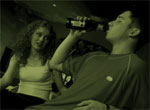 |
||
| Home- | |Facts On Adolescent Binge Drinking | Strategies & Approaches | What You Can Do | Resources & Links | |
|
Center for Applied Research Solutions (CARS) |
|||
Facts On Adolescent Binge Drinking › The Problem: Introduction |
|||
The Problem: Introduction
Specific risk factors/attributes may make certain individuals more at risk for alcohol use and abuse than others. The factors that put teens at risk for alcohol use and abuse include the following:
Peer pressure begins early. One-third of 4th graders and more than half of 6th graders say they have been pressured by friends to drink alcohol. Trauma. Adolescents in treatment for alcohol abuse or dependence report higher rates of physical abuse, sexual abuse, violent victimization, witnessing violence, and similar traumas than other teens. The introduction of distilled beverages such as alcopops, provides additional “sweet” beverage choices for youth which may increase the risk to binge drink, as well. In this section, we will discuss the prevalence of underage youth who drink—in particular, binge drink. We will start with data from the state of California, and then look at national trends.
Underage Drinking in California: California Town Hall Meetings. Community Prevention Institute. March, 2006. Facts for Teens: Teens and Alcohol. National Youth Violence Prevention Resource Center. 2002. http://www.safeyouth.org/scripts/teens/alcohol.asp. Accessed on [07/28/06] Youth and Underage Drinking: An Overview. US Department of Health and Human Services. http://ncadi.samhsa.gov/govpubs/RPO990/. [Accessed on 08/01/06] Spear, L.P. Alcohol’s Effects on Adolescents. National Institute on Alcohol Abuse and Alcoholism. 2003. L Underage Drinking in California: California Town Hall Meetings. Community Prevention Institute. March, 2006. http://www.adp.cahwnet.gov/Prevention/townhall/pdf/CA%20Underage%20Drinking%20Survey%20Data%20Report.pdf L Austin, G. and R. Skager. 10th biennial California Student Survey Drug, Alcohol and Tobacco Use 2003-2004. WestEd. California’s Attorney General’s Office. http://safestate.org/documents/CSS03MainFindings.pdf [Accessed on 08/15/06] Underage Drinking in California: California Town Hall Meetings. Community Prevention Institute. March, 2006. Underage Drinking in California: California Town Hall Meetings. Community Prevention Institute. March, 2006. According to a September 2004 analysis by J. Gfroerer, Substance Abuse and Mental Health Services Administration, calculated using the 2003 National Survey on Drug Use and Health. L Centers for Disease Control and Prevention. 2005 Youth Risk Behavior Survey. Available at: www.cdc.gov/yrbss. Accessed on [07/27/06] L Johnston LD, O'Malley PM, Bachman JG, and Schulenberg JE. 2006. Monitoring the Future national results on adolescent drug use: Overview of key findings, 2005. Bethesda, MD: National Institute on Drug Abuse. http://www.monitoringthefuture.org/pubs/monographs/overview2005.pdf. Accessed on [07/31/06] Office of Applied Studies. 2004. Substance Abuse and Mental Health Services Administration. NSDUH Report: Alcohol Dependence or Abuse and Age at First Use. Rockville, MD: Substance Abuse and Mental Health Services Administration. Hingson, R.W., T Heeren, and M.R. Winter. Age at Drinking Onset and Alcohol Dependence. Archives of Pediatrics & Adolescent Medicine. 160:2006. www.archpediatrics.com. [Accessed on 07/14/06] “Alcopops” Saturate Youth Market. Nutrition Health Review: The Consumers’ Medical Journal. 2003; 88:3. MacLeod, A. Sweet drinks that lure kids pack a surprise—alcohol. Christian Science Monitor. 1997; 89(181). Alcohol Concern Factsheet. Jan 2001. Available online at http://www.alcoholconcern.org.uk/files/20030818_151600_alcopops%20factsheet.pdf L Johnston LD, O'Malley PM, Bachman JG, and Schulenberg JE. 2006. Monitoring the Future national results on adolescent drug use: Overview of key findings, 2005. Bethesda, MD: National Institute on Drug Abuse. http://www.monitoringthefuture.org/pubs/monographs/overview2005.pdf. Accessed on [07/31/06] Summary of Findings: What Teens and Adults are Saying about “Alcopops”. Alcohol Policies Project: Center for Science in the Public Interest; May 2001. Stubblefield, B.C. & N. Singh. Studying influences of underage drinking in the United States: a content analytic study of alcohol advertisements in popular magazines. Journal of the Academy of Business and Economics. 2004. Teenage girls targeted for sweet-flavored alcoholic beverages. American Medical Association. Dec. 16, 2004. Layman, M. Alcopop drinks lure young adults. Spectator Online. Seattle University. Jan 21, 2005. http://www.spectator-online.com/vnews/display.v/ART/2005/01/21/41f0b8efb7d00 Layman, M. Alcopop drinks lure young adults. Spectator Online. Seattle University. Jan 21, 2005. http://www.spectator-online.com/vnews/display.v/ART/2005/01/21/41f0b8efb7d00 |
 Some teens are much more likely to drink alcohol than others. The prevalence of underage binge drinking within the state of California is similar to national trends: although many underage youth drink, the percentage that binge drink is small (i.e. approximately 25% of 11th graders binge monthly
Some teens are much more likely to drink alcohol than others. The prevalence of underage binge drinking within the state of California is similar to national trends: although many underage youth drink, the percentage that binge drink is small (i.e. approximately 25% of 11th graders binge monthly